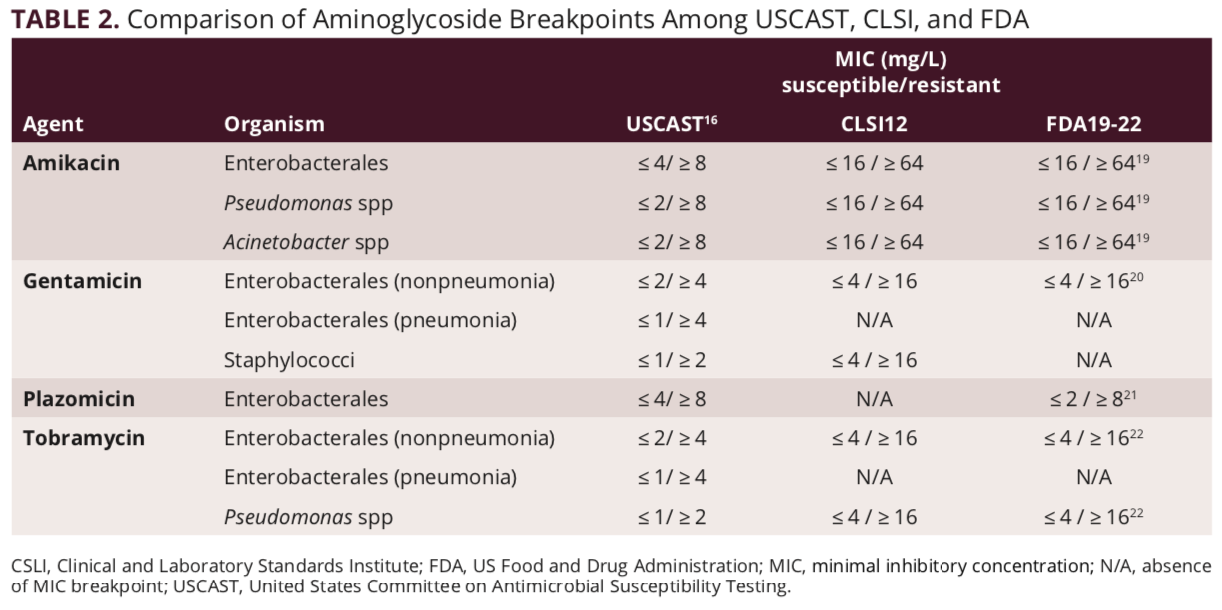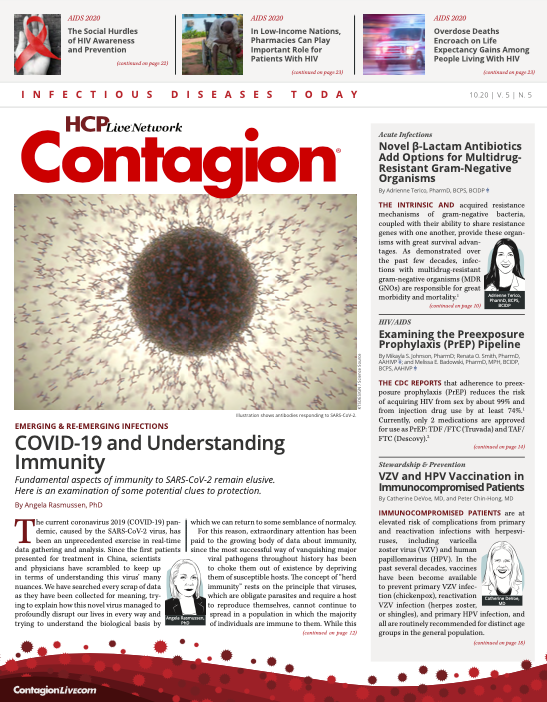What’s New in 2020 From the CLSI Subcommittee on Antimicrobial Susceptibility Testing
The Clinical and Laboratory Standards Institute (CLSI) Subcommittee on Antimicrobial Susceptibility Testing (AST) held its first of two 2020 meetings in January. Due to the coronavirus 2019 pandemic, its midyear meeting was held virtually during several dates in August and September. Although the subcommittee approved several new and revised breakpoints in January 2020, they are subject to change prior to official approval of the meeting minutes at the subsequent meeting(s).
Noteworthy New Breakpoints
Imipenem–relebactam for Proteaceae spp, Providencia spp, Morganella spp, and Serratia spp
Imipenem is a carbapenem with broad-spectrum activity against gram-negative, gram-positive, and anaerobic bacteria, including those expressing extended-spectrum b-lactamases.1 This b-lactam agent has been in use for decades and exerts its bactericidal activity by inhibiting penicillin-binding proteins (PBPs) responsible for cell-wall synthesis. Relebactam is a novel, slowly dissociating Ambler class A and class C b-lactamase inhibitor with no intrinsic antibacterial activity; however, when it is given in combination with imipenem, it enhances activity of the carbapenem among susceptible aerobes and prevents its degradation by certain b-lactamases.1 The combination of imipenem and relebactam (I-R) has demonstrated in vitro activity against Pseudomonas aeruginosa and Enterobacterales isolates with difficult-to-treat resistance phenotypes.2 While I-R maintains activity against Klebsiella pneumoniae carbapenemase–producing Enterobacterales, I-R lacks activity against class B metallo-β-lactamases such as VIM, IMP, and NDM.3
I-R was approved by the FDA in 2019 for treatment of complicated urinary tract infections (cUTI), intraabdominal infections, hospital-acquired bacterial pneumonia (HABP), and ventilator-associated bacterial pneumonia (VABP). The FDA-approved dosing is 1.25 grams (imipenem 500 mg, cilastatin 500 mg, relebactam 250 mg) intravenously (IV) every 6 hours, administered over 30 minutes.1
Upon approval, I-R had FDA-approved breakpoints for disk diffusion (DD) and broth microdilution (BMD) for Enterobacterales, P aeruginosa, and anaerobes (Table 1). The AST subcommittee reviewed studies from epidemiological cutoff values, disk correlation, pharmacokinetic/pharmacodynamic (PK/PD) analyses, clinical studies, and outcomes by minimal inhibitory concentration (MIC) for indicated pathogens to validate the proposed CLSI breakpoints for publication in the M100 document. Data that were presented verified these proposed breakpoints for I-R; they demonstrated clinical efficacy and favorable outcomes across indications.2,4-7

The AST subcommittee deemed that there is potential for further investigation into clinically appropriate dosing, because the PK/PD data that were presented suggested the use of higher doses for isolates with higher MIC values. There was also evidence of higher MICs at lower pH values, suggesting instability of imipenem in acidic conditions.2
Considering all data presented, the AST subcommittee approved the proposed FDA breakpoints for Enterobacterales and P aeruginosa with a comment that they do not apply to Proteeae. It also accepted the proposed FDA breakpoints for anaerobes. For all species, the committee noted that isolates that are susceptible to imipenem alone do not need to be tested in combination with relebactam. A final motion was passed to investigate breakpoints for other organisms within the spectrum of imipenem, specifically Proteaceae spp, Providencia spp, Morganella spp, and Serratia spp, to expand upon the current table.
Noteworthy Revised Breakpoints
Ceftolozane–tazobactam for Haemophilus influenzae
Ceftolozane–tazobactam (C/T) is a cephalosporin and b-lactamase inhibitor combination drug for the treatment of gram-negative infections. Ceftolozane has bacterial activity against both gram-negative and gram-positive organisms upon binding to and inactivating the cell wall of PBPs.8 When ceftolozane is combined with tazobactam, which irreversibly binds to b-lactamase enzymes produced by the organism, it is then able to treat b-lactamase–producing organisms.8,9The combination has been FDA approved since 2014 for the treatment of cUTI and intraabdominal infections at a dose of 1.5 grams every 8 hours given IV over an hour-long period.10 In 2019, the FDA also approved C/T for the treatment of HABP and VABP at the higher dose of 3 grams every 8 hours given IV over an hour.11
At the January 2020 meeting, the manufacturer requested the addition of HABP and VABP MIC breakpoints for Haemophilus influenzae. The FDA breakpoints for H influenzae that were previously approved for the cUTI and intraabdominal indications for susceptibility (S = ≤0.5/4 mg/L) were voted to be modified to include HABP and VABP as indications and added to the upcoming 31st edition of M100: Performance Standards for Antimicrobial Susceptibility Testing.12 In clinical trials for the HABP and VABP indications, the isolate distributions appeared similar to the large-scale surveillance isolates necessary to assess MIC breakpoints. Additionally, the available PK/PD data supported the FDA and European Committee for Antimicrobial Susceptibility breakpoints, and the Monte Carlo simulations showed the probable target attainment was >90%, which is the maximal killing effect, at the S = ≤0.5/4 mg/L breakpoint.13
Methicillin (oxacillin) for coagulase-negative Staphylococcus spp
The consensus is that the gold standard for identifying methicillin (oxacillin) resistance in coagulase-negative Staphylococcus spp is the presence of the mecA gene. Other methods for detecting resistance include oxacillin and cefoxitin BMD and DD, or penicillin-binding protein 2a (PBP2a) tests. However, PBP2a tests are not FDA approved. All 3 methods were investigated, along with mecA and mecC polymerase chain reaction (PCR), on isolates of S capitis, S haemolyticus, S warneri, S hominis, and S epidermis, and 3 strains of S aureus were analyzed for quality control to determine which was the best for detecting resistance.
The results of PBP2a testing conducted via lateral flow assays were extensively consistent with PCR results.14 Oxacillin and cefoxitin MIC and DD results prompted the committee to propose an increase in the oxacillin susceptibility breakpoint from ≤0.25 mg/L to ≤0.5 mg/L for all staphylococci except S aureus and S lugdunensis, and to remove the oxacillin DD breakpoint for S epidermis for simplification of the table in the M100 document. The revised oxacillin breakpoints (Table 1) were passed, as was a motion to keep the comment that PBP2a and mecA testing are the most definitive testing methods for methicillin resistance and may be used for isolates from serious infections with MICs of 0.5 to 2 mg/L. The breakpoints of oxacillin DD for S epidermis were retained with a comment that cefoxitin disks are the preferred method.
Other News: Future Aminoglycoside Breakpoint Evaluation
Clinical data currently suggest safety concerns with the use of aminoglycosides that include nephrotoxicity, potentially leading to acute dose-dependent kidney failure, and ototoxicity, possibly leading to permanent complete or partial hearing loss.15 The United States Committee on Antimicrobial Susceptibility Testing (USCAST), established in 2015, released MIC breakpoints for 4 aminoglycoside antibiotics in 2020, all but 1 of which are lower than the current CLSI and FDA breakpoints: Enterobacterales, Pseudomonas spp, Acinetobacter spp, and Staphylococci (Table 2).16 Plazomicin, the newest aminoglycoside, approved by the FDA in 2018, was expected to be discussed at the midyear 2020 CLSI meeting, but this discussion has been rescheduled for the fall.17 Due to the concerns about other aminoglycoside class antibiotics, CLSI plans to review and possibly revise these breakpoints at a future meeting.

Hirsch is an appointed adviser to the CLSI Subcommittee on AST. She is also an associate professor at the University of Minnesota College of Pharmacy and runs the Hirsch Laboratory in the Experimental & Clinical Pharmacology Department, where Bixby and Billmeyer are a graduate student and a pharmacy student, respectively.
References
- Recarbrio. Prescribing information. Merck; July 2019. Accessed July 28, 2020. https://www.accessdata.fda.gov/drugsatfda_docs/label/2019/212819s000lbl.pdf
- Karlowsky JA, Lob SH, Raddatz J, et al. In vitro activity of imipenem/relebactam and ceftolozane/tazobactam against clinical isolates of gram-negative bacilli with difficult-to-treat resistance and multidrug-resistant phenotypes – SMART United States 2015-2017. Clin Infect Dis. Published online April 3, 2020. doi:10.1093/cid/ciaa381
- Livermore DM, Warner M, Mushtaq S. Activity of MK-7655 combined with imipenem against Enterobacteriaceae and Pseudomonas aeruginosa. J Antimicrob Chemother. 2013;68(10):2286-2290. doi:10.1093/jac/dkt178
- Mavridou E, Melchers RJB, van Mil ACHAM, et al. Pharmacodynamics of imipenem in combination with β-lactamase inhibitor MK7655 in a murine thigh model. Antimicrob Agents Chemother. 2015;59(2):790-795. doi:10.1128/AAC.03706-14
- Lucasti C, Vasile L, Sandesc D, et al. Phase 2, dose-ranging study of relebactam with imipenem-cilastatin in subjects with complicated intra-abdominal infection. Antimicrob Agents Chemother. 2016;60(10):6234-6243. doi:10.1128/AAC.00633-16
- Sims M, Mariyanovski V, McLeroth P, et al. Prospective, randomized, double-blind, phase 2 dose-ranging study comparing efficacy and safety of imipenem/cilastatin plus relebactam with imipenem/cilastatin alone in patients with complicated urinary tract infections. J Antimicrob Chemother. 2017;72(9):2616-2626. doi:10.1093/jac/dkx139
- Motsch J, Murta de Oliveira C, Stus V, et al. RESTORE-IMI 1: a multicenter, randomized, double-blind trial comparing efficacy and safety of imipenem/relebactam vs colistin plus imipenem in patients with imipenem-nonsusceptible bacterial infections. Clin Infect Dis. 2020;70(9):1799-1808. doi:10.1093/cid/ciz530
- PubChem compound summary for ceftolozane (CID 53234134). National Center for Biotechnology Information. Accessed July 28, 2020. https://pubchem.ncbi.nlm.nih.gov/compound/Ceftolozane
- PubChem compound summary for tazobactam (CID 123630). National Center for Biotechnology Information. Accessed July 28, 2020. https://pubchem.ncbi.nlm.nih.gov/compound/Tazobactam
- Zerbaxa. Prescribing information. Merck; December 2014. Accessed July 24, 2020. https://www.accessdata.fda.gov/drugsatfda_docs/label/2014/206829lbl.pdf
- FDA approves new treatment for hospital-acquired and ventilator-associated bacterial pneumonia. News release. FDA; June 3, 2019. Accessed July 24, 2020. https://www.fda.gov/news-events/press-announcements/fda-approves-new-treatment-hospital-acquired-and-ventilator-associated-bacterial-pneumonia
- Clinical Laboratory Standards Institute (CLSI) M100: Performance Standards for Antimicrobial Susceptibility Testing. 30th ed. CLSI; 2020.
- Mouton JW, Dudley MN, Cars O, et al. Standardization of pharmacokinetic/pharmacodynamic (PK/PD) terminology for anti-infective drugs: an update. J Antimicrob Chemother. 2005;55(5):601-607. doi:10.1093/jac/dki079
- Clinical Laboratory Standards Institute (CLSI) Subcommittee on Antimicrobial Susceptibility Testing. January 2020 AST Meeting Agenda Summary: Coagulase-negative Staphylococcus WG Report. Clinical Laboratory Standards Institute; 2020. Accessed July 29, 2020. xxx.
- Jiang M, Karasawa T, Steyger PS. Aminoglycoside-induced cochleotoxicity: a review. Front Cell Neurosci. 2017;11:308. doi:10.3389/fncel.2017.00308
- United States Committee on Antimicrobial Susceptibility Testing (USCAST). Breakpoint tables for interpretation of MIC and zone diameter results, version 6.0. USCAST; 2020. Accessed July 29, 2020. https://app.box.com/s/thbtvevgchp86cdfbu2r2samkum28rhb
- Antibacterial susceptibility test interpretive criteria. FDA. June 4, 2020. Accessed August 4, 2020. https://www.fda.gov/drugs/development-resources/antibacterial-susceptibility-test-interpretive-criteria
- Clinical Laboratory Standards Institute (CLSI). M100: Performance Standards for Antimicrobial Susceptibility Testing. 29th ed. CLSI; 2019.
- Amikacin sulfate. Prescribing information. Sagent; 2018. Accessed August 4, 2020. https://www.sagentpharma.com/wp-content/uploads/2018/12/Amikacin-Sulfate-Inj-USP_PI-Feb-2018.pdf
- Gentamicin. Prescribing information. Hospira; October 2013. Accessed August 4, 2020. https://www.accessdata.fda.gov/drugsatfda_docs/label/2014/062366s033lbl.pdf
- Zemdri. Prescribing information. Achaogen; June 2018. Accessed August 4, 2020. https://www.accessdata.fda.gov/drugsatfda_docs/label/2018/210303orig1s000lbl.pdf
- Tobramycin. Prescribing information. TEVA; December 2008. Accessed August 4, 2020. https://www.accessdata.fda.gov/drugsatfda_docs/label/2009/050789s005lbl.pdf

